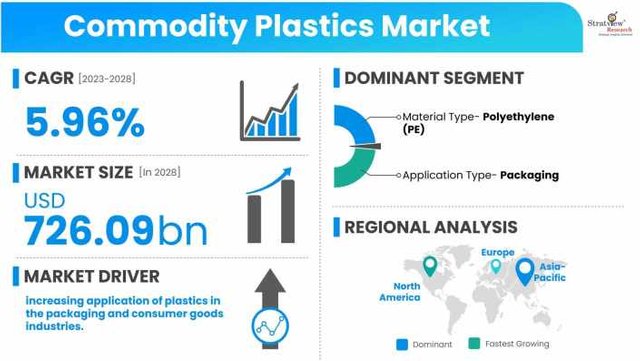Key Market Trends in Commodity Plastics: Drivers, Restraints, and Opportunities
The commodity plastics market is undergoing significant changes, driven by technological advancements, shifts in consumer demand, and global sustainability efforts. These trends are shaping the industry landscape, creating new opportunities and challenges for stakeholders.
According to Stratview Research, the commodity plastics market was estimated at USD 511.25 billion in 2022 and is likely to grow at a CAGR of 5.96% during 2023-2028 to reach USD 726.09 billion in 2028.

Market Drivers
1. Rising Demand from Packaging and Automotive Industries: The packaging sector remains the largest consumer of commodity plastics like polyethylene and polypropylene, owing to their lightweight, durable, and cost-effective properties. Similarly, the automotive industry's push for lighter vehicles to improve fuel efficiency has led to increased usage of plastics over traditional materials like metals.
2. Urbanization and Population Growth: With rapid urbanization, particularly in developing regions, there is a growing demand for consumer goods, housing, and infrastructure. This has resulted in increased consumption of commodity plastics in applications such as construction materials, household products, and electronics.
3. Cost-Efficiency and Versatility: Commodity plastics are favored for their low production costs and adaptability to a wide range of applications. Industries across sectors rely on these materials for creating affordable and efficient solutions.
Market Restraints
1. Environmental Concerns and Regulations: The non-biodegradable nature of most commodity plastics has raised environmental concerns, leading to stricter government regulations and increasing consumer preference for eco-friendly alternatives. Countries are implementing bans on single-use plastics, challenging the market growth.
2. Volatility in Raw Material Prices: The market heavily depends on petrochemical derivatives, making it vulnerable to fluctuations in crude oil prices. These price changes can impact production costs and profit margins, particularly for smaller manufacturers.
3. Growing Competition from Bioplastics: Bioplastics, made from renewable resources, are gaining traction as sustainable alternatives to traditional plastics. This shift could gradually erode the demand for conventional commodity plastics.
Opportunities
1. Technological Innovations: Advances in recycling technologies and the development of bio-based commodity plastics present significant opportunities. Circular economy initiatives are encouraging the creation of reusable and recyclable plastic products.
2. Emerging Markets: Asia-Pacific, Latin America, and Africa are witnessing increased industrialization and urbanization. These regions represent untapped markets with high growth potential for commodity plastics manufacturers.
3. Focus on Sustainable Practices: Companies investing in green manufacturing processes and collaborating on environmental initiatives are positioning themselves as market leaders while addressing ecological concerns.
In conclusion, while the commodity plastics market faces challenges, innovations and strategic adaptations offer a pathway to sustainable growth. By leveraging these trends, businesses can remain competitive and thrive in this dynamic industry.